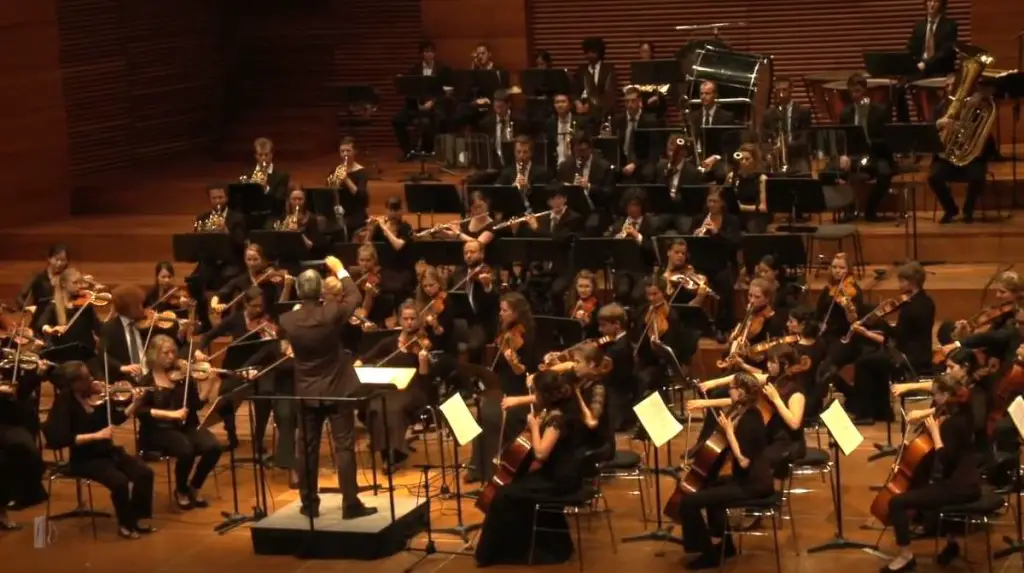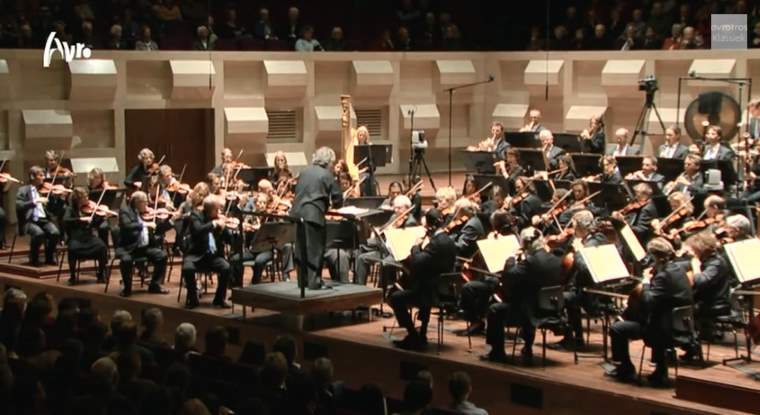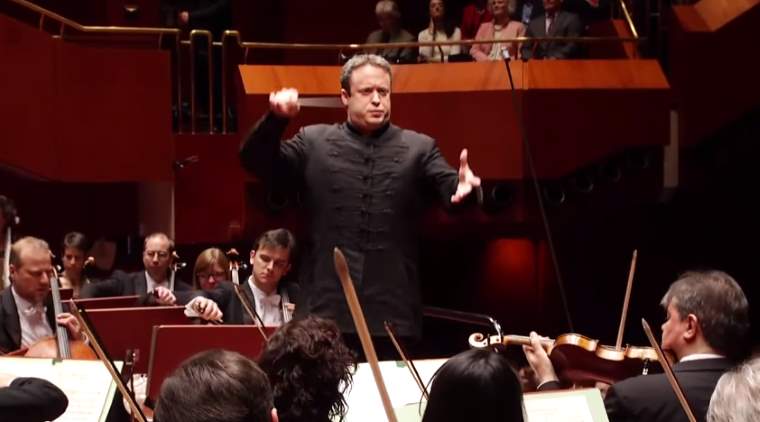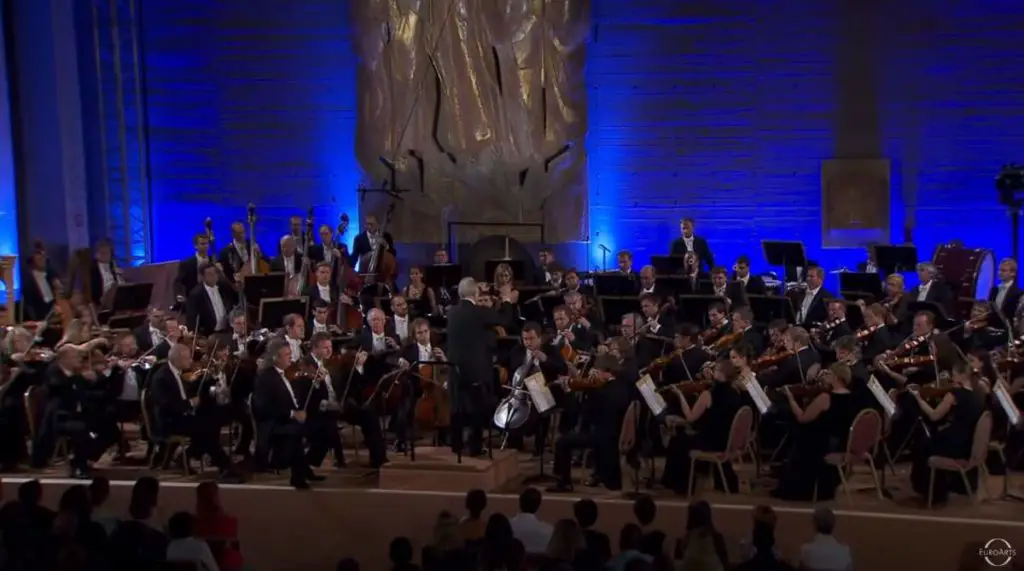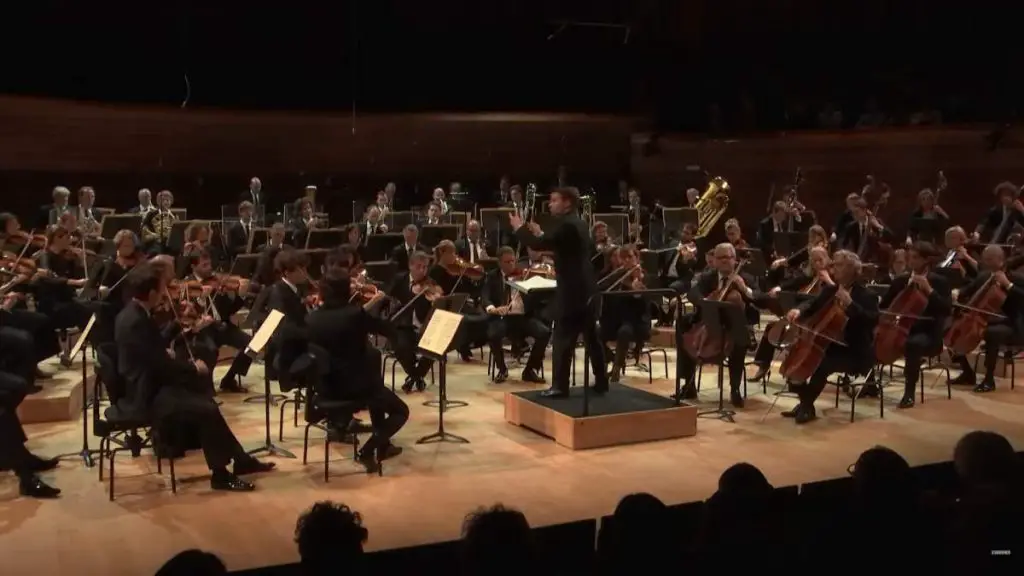Conducted by Maciej Tomasiewicz, the Szymanowski Youth Symphony Orchestra performs Nikolai Rimsky-Korsakov’s Scheherazade, Op. 35, a symphonic suite composed in 1888. Concertmaster (lead violinist): Olivia Bujnowicz-Wadowska. This performance was recorded at the Silesian Philharmonic Concert Hall in Katowice, Poland, on June 6, 2019.
Nikolai Rimsky-Korsakov’s Scheherazade
Nikolai Rimsky-Korsakov’s “Scheherazade,” Op. 35, is a symphonic suite composed in 1888 and stands as one of the most popular and celebrated works in the orchestral repertoire. Inspired by “One Thousand and One Nights,” also known as “The Arabian Nights,” the piece is a musical depiction of the tales told by Scheherazade to postpone her execution by the Sultan Schariar. Through this work, Rimsky-Korsakov demonstrates his mastery of orchestration and his ability to evoke vivid imagery and emotions through music.
“Scheherazade” is notable for its rich thematic material, innovative orchestration, and the use of a programmatic structure to tell a story without words. Rimsky-Korsakov employs a large orchestra, making use of a wide range of instruments to create a colorful tapestry of sounds that evoke the exotic atmosphere of the Arabian tales. The suite is renowned for its lush harmonies, dynamic contrasts, and the evocative melodies that transport the listener to a fantastical realm.
The work is structured around four movements, each inspired by different tales from “The Arabian Nights.” However, rather than providing a direct musical depiction of specific stories, Rimsky-Korsakov focuses on creating an overall mood and atmosphere that reflects the spirit of Scheherazade’s storytelling. The composer uses recurring themes to represent the characters, most notably the theme associated with Scheherazade herself, which is introduced by a solo violin and accompanied by a harp. This theme serves as a leitmotif, weaving through the suite and symbolizing the presence and voice of the storyteller.
“Scheherazade” showcases Rimsky-Korsakov’s skill in thematic development and his innovative approach to form. While the movements are linked thematically, each possesses its own distinct character and mood, ranging from the adventurous and dramatic to the tender and lyrical. The suite is a masterpiece of orchestration, demonstrating the composer’s ability to blend and contrast different timbres and textures to achieve a rich, immersive sound.
The suite’s premiere was met with critical acclaim and has since become a staple of the orchestral repertoire, beloved by audiences and musicians alike. Its appeal lies not only in its musical brilliance and inventive orchestration but also in its ability to evoke a vivid, imaginary world brimming with adventure, romance, and mystery.
Movements
With start times in the video:
- 00:39 The Sea and Sinbad’s Ship
- 10:38 The Story of The Kalendar Prince
- 21:53 The Young Prince and The Young Princess
- 31:46 Festival at Baghdad. The Sea. The Ship Breaks against a Cliff Surmounted by a Bronze Horseman
1. The Sea and Sinbad’s Ship
The first movement of Nikolai Rimsky-Korsakov’s “Scheherazade,” Op. 35, is titled “The Sea and Sinbad’s Ship.” It serves as a vivid and dynamic introduction to the suite, immediately immersing the listener in the exotic and adventurous world of “The Arabian Nights.” This movement is characterized by its sweeping themes, vivid orchestration, and the dramatic interplay between the orchestra and the solo violin representing Scheherazade herself.
Opening with a powerful statement from the full orchestra, the movement sets the stage for a tale of grandeur and mystery. The initial theme, bold and imposing, evokes the majesty and tumult of the sea, setting a backdrop for Sinbad’s nautical adventures. This is followed by the entrance of the Scheherazade theme, played by a solo violin with a delicate harp accompaniment. The theme is lyrical and seductive, symbolizing the voice of Scheherazade as she begins her storytelling.
The movement is structured around these contrasting themes, with the orchestration playing a key role in depicting the narrative. Rimsky-Korsakov’s use of different sections of the orchestra creates a rich tapestry of sound, with woodwinds, brass, and strings each contributing to the evocative atmosphere. The music oscillates between the stormy and the serene, mirroring the tumultuous journey of Sinbad’s ship on the open sea.
Throughout the movement, the solo violin reappears, weaving the narrative thread and reminding the listener of Scheherazade’s presence. The interplay between the solo violin and the orchestra is one of the defining features of the movement, showcasing Rimsky-Korsakov’s skill in orchestration and his ability to create a musical dialogue that is both engaging and emotive.
The development section sees the themes transformed and elaborated, building to moments of intense drama that suggest the perilous adventures faced by Sinbad. The orchestration here is particularly striking, with Rimsky-Korsakov using the full range of the orchestra’s capabilities to create dynamic shifts and vivid imagery.
The movement concludes with a return to the Scheherazade theme, now more reflective and poignant, suggesting the ongoing nature of the storytelling and the transition to the tales that follow. The ending is both grand and introspective, leaving the listener in anticipation of the next chapter in the suite.
2. The Story of the Kalendar Prince
The second movement of Nikolai Rimsky-Korsakov’s “Scheherazade,” Op. 35, titled “The Story of the Kalendar Prince,” continues the suite’s exploration of the tales from “The Arabian Nights” with a focus on the adventures and misfortunes of a prince who disguises himself as a wandering Kalendar (a type of Muslim monk). This movement is marked by its vivid characterizations, intricate orchestration, and the expressive use of solo instruments to convey the narrative.
The movement opens with a sense of mystery and anticipation, quickly moving into a series of solo passages that introduce the Kalendar Prince’s theme. The solo clarinet plays a prominent role, presenting a melody that is at once exotic and expressive, suggesting the prince’s noble origins and adventurous spirit. This theme is characterized by its sinuous melodies and ornamental flourishes, evoking the Middle Eastern setting of the tales.
As the movement progresses, Rimsky-Korsakov employs a variety of solo instruments, including the violin, flute, oboe, and bassoon, to develop the thematic material and add layers of complexity to the narrative. Each solo passage contributes to the storytelling, offering a musical depiction of the prince’s journey, his encounters, and his emotions. The interplay between the solo instruments and the orchestra creates a rich tapestry of sound, showcasing Rimsky-Korsakov’s mastery of orchestration.
The movement is structured to allow for dramatic contrasts, with moments of intense emotion and serene beauty. The use of varying dynamics, tempi, and harmonic colors adds to the expressive depth of the music, drawing the listener into the prince’s story. The orchestration is particularly notable for its use of the harp and strings to create textures that are both lush and delicate, providing a backdrop to the solo passages that is evocative of the suite’s fairy-tale atmosphere.
One of the highlights of the movement is the cadenza-like passages for the solo violin, which return to the Scheherazade theme introduced in the first movement. These passages serve as a reminder of the framing device of the tales, with Scheherazade herself narrating the prince’s adventures. The solo violin, representing Scheherazade’s voice, is both poignant and captivating, weaving through the orchestral texture with grace and agility.
The movement concludes with a return to the Kalendar Prince’s theme, now transformed and enriched by the musical journey. The ending is both dramatic and introspective, leaving the listener with a sense of the prince’s changed circumstances and the enduring power of his story.
3. The Young Prince and the Young Princess
The third movement of Nikolai Rimsky-Korsakov’s “Scheherazade,” Op. 35, titled “The Young Prince and The Young Princess,” is often celebrated for its lyrical beauty and tender expressiveness. This movement represents a more romantic and narrative-driven segment of the suite, illustrating the love story between a young prince and princess within the fantastical framework of “The Arabian Nights.”
Characterized by its sweeping melodies and delicate orchestration, the third movement showcases Rimsky-Korsakov’s ability to paint vivid musical pictures. The movement opens with a gentle, flowing theme introduced by the strings, evoking the grace and elegance of the young princess. This theme is notable for its warmth and lyricism, setting a romantic and somewhat wistful tone for the movement.
As the music unfolds, the theme is passed among various sections of the orchestra, each adding its own color and texture to the narrative. The solo violin, which represents the voice of Scheherazade throughout the suite, plays a significant role in this movement, weaving in and out of the orchestral texture with solos that are both intricate and emotive. The violin solos here are more reflective and nuanced, reflecting the intimate and personal nature of the love story being told.
The melody associated with the young prince is introduced by the woodwinds and is characterized by its nobility and strength. This theme complements the princess’s theme, and together, they create a musical dialogue that mirrors the interaction between the two characters. The interplay between these themes, set against the backdrop of the orchestra, brings the story of the young lovers to life, filled with moments of tenderness, passion, and longing.
Rimsky-Korsakov’s orchestration in this movement is particularly effective in creating a sense of atmosphere and setting. The use of harps, woodwinds, and strings lends the music a texture that is both lush and delicate, perfectly capturing the enchanted world in which the young prince and princess’s story unfolds.
The movement progresses through a series of variations on these themes, exploring different moods and expressions. Rimsky-Korsakov demonstrates his skill in variation form, subtly altering the melodies and harmonies to reflect the evolving narrative. The orchestration remains sensitive and nuanced throughout, with each variation adding depth and detail to the story.
The movement concludes with a reprise of the opening themes, now intertwined in a musical representation of the union between the prince and princess. The ending is both sweet and melancholic, leaving the listener with a sense of the enduring beauty and fragility of their love.
4. Festival at Baghdad. The Sea. The Ship Breaks against a Cliff Surmounted by a Bronze Horseman
The fourth and final movement of Nikolai Rimsky-Korsakov’s “Scheherazade,” Op. 35, titled “Festival at Baghdad. The Sea. The Ship Breaks against a Cliff Surmounted by a Bronze Horseman,” is a dramatic and vivid conclusion to the suite. This movement encapsulates the essence of “The Arabian Nights” with its dynamic energy, colorful orchestration, and narrative intensity, reflecting the tumultuous events of a festival in Baghdad, a storm at sea, and the dramatic shipwreck.
Rimsky-Korsakov’s genius in orchestration is fully displayed here, with the entire orchestra being used to create a vibrant tapestry of sounds that evoke the bustling atmosphere of Baghdad, the chaos of the storm, and the majesty of the sea. The movement begins with a lively and spirited theme that suggests the excitement and festivity of Baghdad. This theme is characterized by its rhythmic drive and the brilliant use of brass and percussion to convey the celebratory mood.
As the movement progresses, the music transitions to depict the sea, introducing themes that capture the ebb and flow of the waves and the vastness of the ocean. Rimsky-Korsakov employs strings and woodwinds to create fluid, undulating patterns that mimic the movement of water, setting the stage for the ensuing storm.
The storm section is one of the most compelling parts of the movement, showcasing Rimsky-Korsakov’s ability to convey dramatic action through music. The orchestra erupts with forceful dynamics, dissonant harmonies, and rapid passages that depict the fury of the storm and the perilous journey of the ship. The music builds in intensity, culminating in the climactic moment when the ship breaks against a cliff surmounted by a bronze horseman – a statue that, according to legend, marks the site of a shipwreck.
In this climax, the orchestra reaches a peak of tension and power, with the brass and percussion playing a prominent role. The use of a wide range of dynamics, from whisper-quiet to thunderously loud, adds to the dramatic impact of the scene. The moment of the shipwreck is vividly portrayed through a dramatic orchestral gesture, leaving the listener with a sense of awe at the forces of nature and fate.
Following the climax, the music gradually subsides, returning to the Scheherazade theme introduced by the solo violin. This return serves as a reminder of the frame story of Scheherazade narrating tales to the Sultan, and it brings a sense of closure to the suite. The movement, and the suite as a whole, end with a reflective and somewhat melancholic recapitulation of the main themes, suggesting the enduring power of storytelling and the imagination.
Sources
- Scheherazade (Rimsky-Korsakov) on Wikipedia
- Scheherazade, Op.35 (Rimsky-Korsakov, Nikolay) on the International Music Score Library Project website
